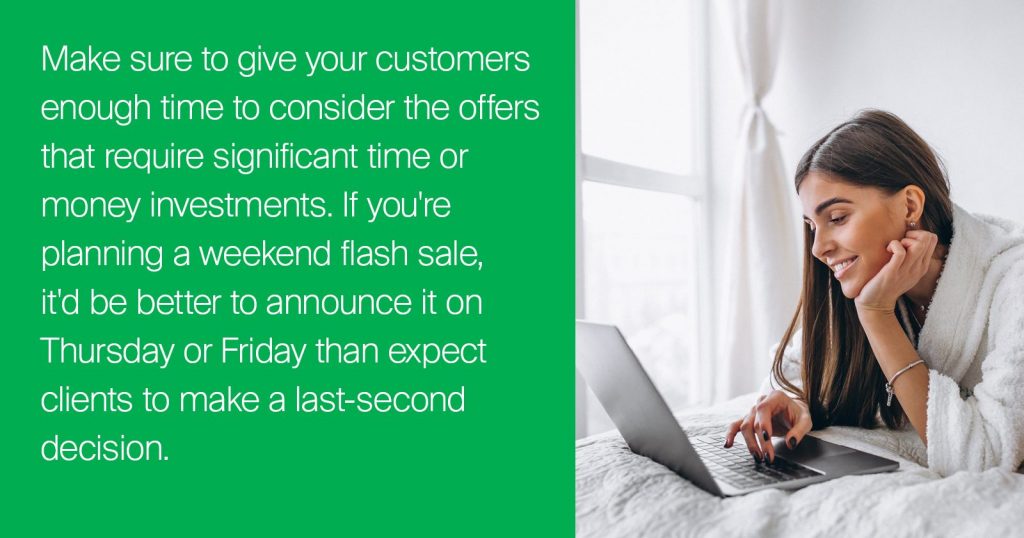Selling a fantastic product or providing sublime services is only half the battle. Delivering your marketing message to consumers when they need it the most, is what helps to seal the deal. Timing your business messaging campaign to meet consumer needs is critical for its success, be it via SMS or through Viber.
You could be offering an amazing discount supported by the most sublime copy ever written, yet if you send out a campaign at the wrong time, your efforts could go to waste. It works the other way around as well. A less attractive offer could perform significantly better and generate higher engagement if timed right.
Mastering the basics
Coming up with the best time to schedule mobile marketing campaigns will depend on your goals, industry and customer habits.
Here are some universally recognised timings for sending promotional messages:
- Between 8 a.m. and 12 p.m. on weekdays. This is a popular time to check the notifications while the consumers are on public transport, have their morning coffee, or check their inboxes in the office.
- Between 5 p.m. and 9 p.m. on weekdays. Around this time, customers are once again on their phones on their way back home or busy with their chores and hobbies, yet still ready to receive your messages without considering them intrusive.
- Between 10 a.m. and 12 p.m. on Saturdays and Sundays. Send your campaign while the audience is nice and cosy, relaxing after a week of hard work. Reaching out to your consumer during this time of the day also makes it easier for people to jump on board with the offers that will not disrupt your customer’s plans, like an invitation to check out a new brunch menu.
- Between 4 p.m. and 7 p.m. on Sundays. Finally, early Sunday evenings are when most of us are done with our activities, chilling in preparation for the upcoming week. This is the time for relaxed browsing, which means consumers should be considerably more receptive to your communications.

Retailers should keep track of pay cycles
Thanks to its versatility, business messaging is a perfect tool for retailers. You can promote new products, send exclusive sales offers, confirm order deliveries and much more. Considering how competitive the retail sector is, sending out campaigns at peak times is crucial for success. The optimal time to send out retail messaging campaigns is between 10 am to 12 am on Saturdays, or 10 am to 12 am and 4 pm to 7 pm on Sundays. As we mentioned above, consumers are much more relaxed during the weekend and typically spend more money than on weekdays. But do not forget to announce weekend sales beforehand! Sending campaigns between 2 pm and 5 pm Thursdays and Fridays is a great way to drive foot traffic to your stores. It is best to announce your sale when client have enough cash on them. Retail campaigns sent during the end of the month (26th — 31st) tend to perform better as they coincide with most paydays. As consumers count down the days to their next pay cheque, you want to ensure that your product or service lands at the top of their list of expenses.
Tickle their tastebuds
Text marketing is also very popular amongst restaurants and takeaway owners due to its effectiveness and low time commitment. You can use it to offer discounts, promote seasonal items, collect feedback and for booking and order confirmations. Since consumers typically visit restaurants during the evening, the restaurant and takeaway owners’ peak time to send out messaging campaigns is different from that of retail shops. The challenge is to make sure that campaigns are not sent out too early or too late. Send them too early, and the client may forget about it come evening. Send a campaign too late, and the person has already made up their mind.
Therefore, the optimal time to send out a messaging campaign should be between 3 pm to 5 pm on any day of the week. However, there’s a slightly wider window of opportunity on the weekend — it is so much harder to reject a delicious breakfast delivered to your door when you are still chilling in bed. And then there are sports and similar timed events on stream or TV that can help takeaway owners significantly boost orders by sending a campaign out at around 7 pm.
Raise customer satisfaction
Now we are slowly shifting from promotional to transactional traffic. Customer satisfaction and brand image are just as vital for your future sales as promotion is. By sending out reminders, businesses that offer services that include appointments or meetings (doctors, opticians, salons etc.) can reduce the number of no-shows from customers. This simple activity helps cut costs and demonstrates excellent customer service quality.
We recommend sending out two messages to customers who have an upcoming appointment or meeting. Send the first message immediately after the booking to reassure the customer that your company has confirmed their booking. The second message should be sent 24 hours before the appointment so that your customers can contact you if they need to reschedule.
The expert opinion: How often should you message customers?

Nailing the right messaging frequency is critical for a campaign’s success.
Vadym Podkolzin, Channel Partners Manager, GMS
- The number of messages you send to your clients within one month can make a sizeable difference to your campaign. Bombarding your clients with messages can be the quickest way to lose your audience. “Speaking of promotional messages, we recommend texting customers up to once a week, staying within a 2-4 texts range,” shares Vadym Podkolzin, Channel Partners Manager at GMS.
- Low-frequency campaigns are very effective when dealing with customers who forgot to take action. “You may “activate” a customer who forgot they were in the middle of a purchase with a gentle reminder,” advises Podkolzin.
- High-frequency campaigns are trickier to pull off without becoming annoying. However, they still can serve as a great engagement instrument if handled well. “One of the use scenarios would be an opt-in-based daily update with fun facts about your product or valuable tips and bits of advice your client can benefit from in day-to-day life,” concludes Podkolzin.
Do’s and Don’ts
A few more things you should consider before sending out your campaigns.
- If you target an international audience (or operate in a particularly vast country), it is essential to consider time zones. If you send a campaign at 9 am Eastern Time, customers on the west coast would receive your message at 6 am. There is a good chance you wake up your client, which is not easily forgiven.
- Avoid sending marketing messages on major holidays. An otherwise innocent message can be considered quite intrusive if it interrupts your client’s quality time with his family and loved ones.
- If your audience’s tastes are very… singular, and you are still figuring them out, run an A/B test by splitting your contact list in half and sending the same message at two different times. You can then determine which one was the most successful and proceed sending campaigns to all of your contacts at this time in the future
In conclusion
A well-timed campaign can mean a world of a difference for your brand’s success. Our multichannel messaging platform will help you time and orchestrate your messaging effort to ensure the best results. Contact our experts and bring your messaging to a new level today!

